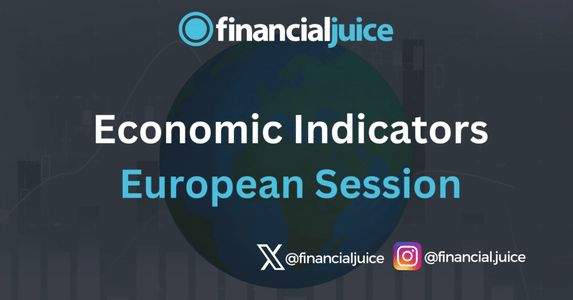
Week Ahead: Economic Indicators (EU)
Hey, Traders!
For the May 6th week, here is a list of all of the major economic indicators being released during the EU Session, with a brief synopsis of what they represent and what to possibly expect from the markets in reaction.
Monday 6th May
03:55 ET
German and Eurozone PMI
Services:
The Eurozone Services PMI (Purchasing Managers’ Index) is based on data collected from a representative panel of around 2,000 private service sector firms. National services data are included for Germany, France, Italy, Spain and the Republic of Ireland. The index tracks variables such as sales, employment, inventories and prices.
Composite:
In the Euro Area, the Markit Eurozone PMI Composite Output Index tracks business trends across both the manufacturing and service sectors, based on data collected from a representative panel of over 5,000 companies (60 percent from the manufacturing sector and 40 percent from the services sector). The index tracks variables such as sales, new orders, employment, inventories and prices. National data are included for Germany, France, Italy, Spain, Austria, the Netherlands, Greece and the Republic of Ireland.
What to expect:
A reading above 50 indicates that the services sector is generally expanding; below 50 indicates that it is generally declining.
Tuesday 7th May
02:00 ET
German Industrial Orders
Manufacturers’ orders are a leading indicator for industrial production.
The figures are calculated every month by the Federal Statistical Office and represent the value of all orders for the delivery of self-made products confirmed by industrial enterprises with 50 or more employees in the respective reporting period.
The results are broken down by both sector and region of origin (domestic and foreign split into euro area and non-euro area). Monthly volatility can be very high, so moving averages give a much better guide to underlying trends.
What to expect:
A higher than expected reading should be taken as positive/bullish for the EUR, while a lower than expected reading should be taken as negative/bearish for the EUR.
Wednesday 8th May
02:00 ET
German Industrial Production
Industrial production measures the physical output of the nation’s factories, mines and utilities. Data are collected from companies in the sector with fifty or more employees and include mining and quarrying, manufacturing, energy and, in contrast to its Eurozone counterpart, construction.
Investors want to keep their finger on the pulse of the economy because it usually dictates how various types of investments will perform. The stock market likes to see healthy economic growth because that translates to higher corporate profits. The bond market prefers more subdued growth that will not lead to inflationary pressures. By tracking economic data such as industrial production, investors will know what the economic backdrop is for these markets and their portfolios.
What to expect:
This report has a big influence on market behavior. In any given month, one can see whether capital goods or consumer goods are growing more rapidly. Are manufacturers still producing construction supplies and other materials? This detailed report shows which sectors of the economy are growing and which are not.
Thursday 9th May
07:00 ET
BoE Interest Rate
The Bank of England’s monetary policy committee members vote on where to set the rate. It could have an effect on businesses for the sudden change in the cost of credit on their corporate balance. Consumers could also be affected since the shifts in Monetary policy influence other short-term rates like Bank deposits, personal loans, credit cards, home equity loans and adjustable-rate mortgages. Higher rates might make banks more reluctant to borrow overnight funds, so might lend out less money or charge businesses and consumers a higher rate to offset the rates.
What to expect:
The pound might rally if the BoE is showing an inclination to keep rates higher for longer. How much the pound might move depends on if the Foreign Exchange Markets have taken these hikes into consideration. If they have taken it into consideration then the dollar movement may be minimal.
Friday 10th May
02:00 ET
UK GDP
Gross Domestic Product (GDP) measures the total value of a country’s industrial output over a given period. It consists of the aggregate domestic production of goods and services by individuals, businesses, and government. GDP data is available in dollar or index form. U.K. GDP QoQ is the comparison of growth from one fiscal quarter to the next, represented in a percentage format.GDPQoQ is a leading indicator of U.K. economic health. High levels of GDP growth are viewed as being positive for U.K. indices as well as the GBP.
What to expect:
The Bank of England (BOE) places a great deal of emphasis on monthly and yearly GDP. Robust growth is often a prelude to monetary tightening, while stagnate levels provide an environment conducive to Quantitative Easing (QE).Traders monitor GDP (MoM) releases closely. Abnormal reports may cause rapid buying or selling of the U.K. indices or GBP. Currency, equities, and commodities markets all exhibit enhanced degrees of volatility surrounding the GDP release.
UK Manufacturing Production
Manufacturing Production measures the change in the total inflation-adjusted value of output produced by manufacturers. Manufacturing accounts for approximately 80% of overall Industrial Production. Manufacturing output is the preferred number rather than industrial production which can be unduly influenced by electrical generation and weather. The manufacturing index is widely used as a short-term economic indicator in its own right by both the Bank of England and the UK government. Market analysts also focus on manufacturing and its sub-sectors to get insight on industry performance.
What to expect:
A higher than expected reading should be taken as positive/bullish for the GBP, while a lower than expected reading should be taken as negative/bearish for the GBP.



